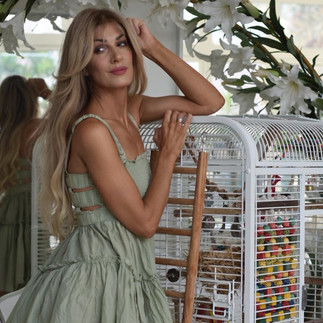Let me share with you my story: How we rescued injured an Indian - Ring -Neck -Parrot.

Hey everyone! I'm so excited to finally share this story that's been brewing in my heart for months. On the 20th of May, we found a little angel - a small parrot with a bleeding chest, unable to fly. We named her Apple, because she showed an undying love for this crunchy fruit!
Apple is a warrior, embracing her treatment with trust and patience, teaching us so much about acceptance and resilience. It reminded me of how important it is to allow ourselves to be vulnerable and to accept help from others when we need it.
After a month and a half, Apple was ready to fly again. We had countless discussions about keeping her, her bright spirit had filled our home with joy. But we knew it was not about us. Just like us, every creature deserves freedom, the chance to make friends, to love, and to live their lives unshackled. That’s exactly what Apple deserved.
So, with hearts full of love and eyes full of tears, we set her free. And yes, for those wondering, she did come back - not because she had to, but because she wanted to. Two days later, as we sat around the kitchen table, we heard a familiar chirp. Running outside, we found Apple, introducing us to her new friend. It was a moment that filled us with indescribable happiness.
Now, every time we hear her voice, we're reminded that she's out there, living her life to the fullest, and that she hasn't forgotten us.
10. Tips How To Rescue and Release Indian Ring Neck Parrot
Understand the Species: The Indian ring-neck parakeet (Psittacula Krameri), also known as the Rose-ringed parakeet, is commonly found in various countries, including India, but also here in Dubai are very common birds and has large populations established in many areas of the country. This knowledge can help inform how to best prepare for the release.
Know the Difference: Releasing a domesticated bird is different from releasing a wild bird. Domesticated birds may not have the necessary survival skills, whereas wild birds, like the Indian ring-neck parakeet, naturally exist in the wild and may have a higher chance of survival after release.
Ensure the Bird Is Healthy: Before release, make sure the bird has fully recovered from any injuries or illnesses. If the bird was in captivity due to injury, consult with a veterinarian or bird rehabilitation specialist to ensure it's fit for release.
Familiarize with Natural Diet: The diet of Indian ring-neck parakeets consists of seeds, nuts, berries, blossoms, and fruits. Before release, ensure that the bird is used to foraging for its natural diet to increase its chances of survival in the wild.
Safe Release Location: Opt for a location that mirrors the bird's natural habitat. For the Indian ring-neck, areas near forests, farmlands, or woodlands adjoining cultivated areas would be ideal. The fact that you observe flocks of these parrots around your garden is a positive sign for release.
Release During Active Times: The best time to release parakeets is during the morning when they are most active and can easily find food and shelter.
Avoid Disturbances: If you are hand-rearing baby parakeets, it's crucial not to disturb parent birds if they are sitting on eggs, as per the provided source. The same principle of minimizing disturbance applies when releasing birds.
Monitor After Release: Even after releasing the bird, monitor it for a few days (from a distance) to ensure that it is adapting well to its environment, finding food, and not facing threats from predators.
Legal Considerations: While this isn't directly related to the physical release, it's worth noting that in India, the Ring-necked parakeets are listed under Schedule IV of the Wildlife (Protection) Act 1972, which makes it illegal to own them, which I personally find totally correct, the question comes to injured birds, I hope in this case, I believe under name of rescuing them its fine to keep them until they are recovered. Always be informed about local wildlife laws when rescuing and releasing birds.
Stay Educated: Always keep yourself informed about the species you're rescuing, especially if it's a wild bird. This helps in understanding their needs and ensuring that they have the best chance of survival upon release.
Remember, the ultimate goal is to give the bird a chance to thrive in its natural environment. Your compassion and efforts in rescuing and releasing the bird are commendable.
This experience with rescuing Apple, has been a powerful reminder of how every life, no matter how small, deserves respect, care, and most importantly, freedom. When we treat animals with kindness, we aren't just improving their lives, we're enriching ours too. Let’s make our world a place where every creature, from the smallest ant to the largest elephant, can feel loved and respected. Please respect all animals, they are like us, full of joy, emotions and love.
If you like my content, please do not forget to Subscribe my mailing list to stay up to date.
Happy day my dearest Friends.
Yours in stilettos,
XOXO Henrieta
#lovealllife #animallovers #animalsareawesome #loveislove #birdsofinstagram #respectanimals #freebird #rescuedbirdsofinstagram #rescuedbirds #ringneckparrot #parrotlover


















Comentarios